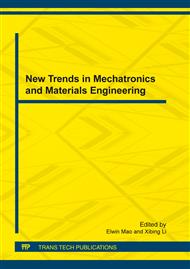[1]
F.G. Tian, J.B. Li, J.L. Gao, W.Q. Tao, L. Liao, H.P. Quan, Development of Tackifier and Shear Strength-improving Agent YF-01 for Drilling Fluids, Adv. Fin. Petrochem. Chem. 10 (2009) 4-8.
Google Scholar
[2]
J.N. Yan, Drilling fluid technology, first ed., Petroleum Industry Press, Beijing, (2003).
Google Scholar
[3]
Prakash Acharya, Process Challenges and Evaluation of Bed Agglomeration in a Circulating Bed Combustion System Incinerating Red Water, Environ. Prog. 16 (1997) 54-64.
DOI: 10.1002/ep.3300160121
Google Scholar
[4]
Q.L. Zhao, Z.F. Ye, M.H. Zhang, Treatment of 2, 4, 6-trinitrotoluene(TNT) red water by vacuum distillation, Chemosphere. 80 (2010) 947-950.
DOI: 10.1016/j.chemosphere.2010.05.004
Google Scholar
[5]
C. Rajagopal, J.C. Kapoor, Development of adsorptive removal process for treatment of explosives contaminated wastewater using activated carbon, J. Hazard. Mater. B87 (2001) 73-98.
DOI: 10.1016/s0304-3894(01)00179-0
Google Scholar
[6]
J.W. Lee, T.H. Yang, W.G. Shim, T.O. Kwon, I.S. Moon, Equilibria and dynamics of liquid-phase trinitrotoluene adsorption on granular activated carbon: effect of temperature and pH, J. Hazard. Mater. 141 (2007) 185-192.
DOI: 10.1016/j.jhazmat.2006.06.110
Google Scholar
[7]
W.Y. Tang, S.F. Zhou, L.J. Wang, Q.T. Peng, Mechanism study of biodegradation TNT wastewater, Proc 3rd Int Symposium on Pyrotechnics and Explosives, Beijing, 1995, pp.267-270.
Google Scholar
[8]
Y.G. Wu, J. Jiao, D.W. Zhao, Advanced oxidation processes for treatment of wastewater contaminated by explosives, J. Energetic. Mater. 11 (2003) 166-169.
Google Scholar
[9]
S.J. Chang, Y.C. Liu, Degradation mechanism of 2, 4, 6-trinitrotoluene in supercritical water oxidation, J. Environ. Sci. 19 (2007) 1430-1435.
Google Scholar
[10]
H.S. Son, S.J. Lee, K.D. Zoh, Kinetics and mechanism of TNT degradation in TiO2 photocatalysis, Chemosphere. 57 (2004) 309-317.
DOI: 10.1016/j.chemosphere.2004.05.008
Google Scholar
[11]
D.C. Schmelling, K.A. Gray, Photocatalytic transformation and mineralization of 2, 4, 6-trinitrotoluene(TNT)in TiO2 slurries, Water. Res. 29 (1995) 2651-2662.
DOI: 10.1016/0043-1354(95)00136-9
Google Scholar


